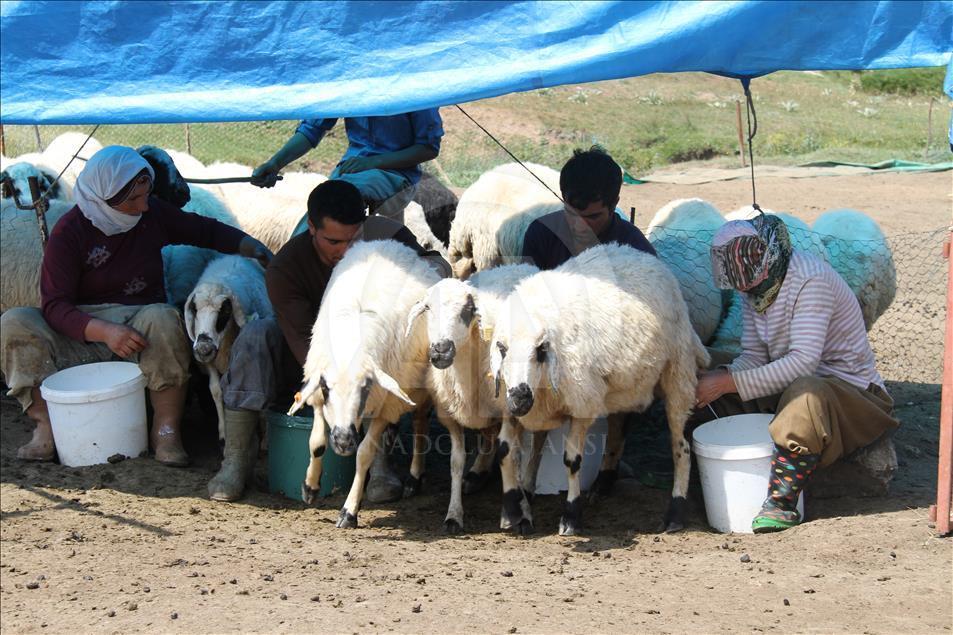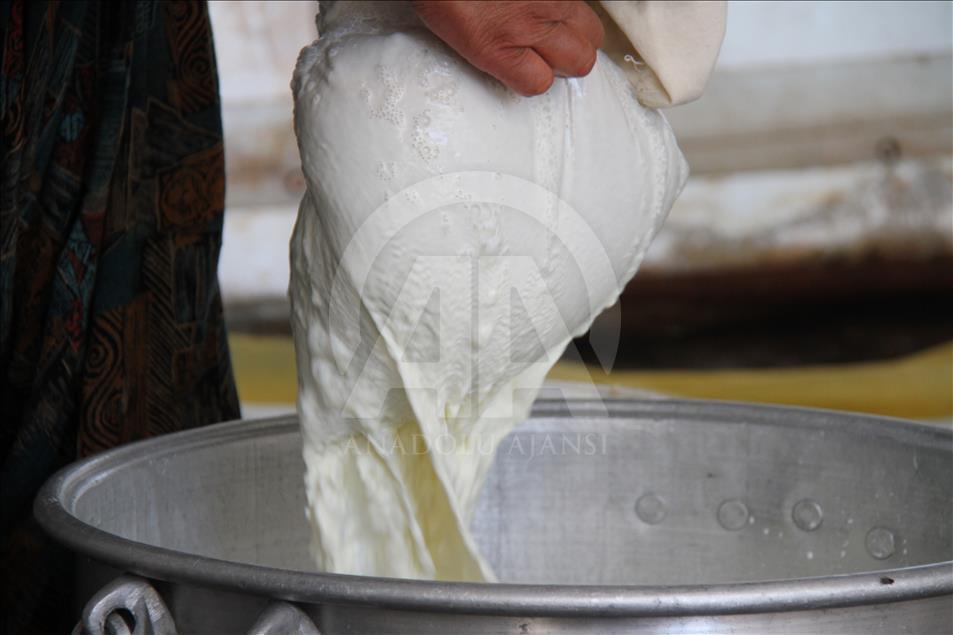Erzincan Tulum Cheese is a semi-hard cheese produced traditionally in Türkiye’s Eastern Anatolia Region, especially in Erzincan province. It is made from sheep’s milk and matured inside a tulum (a type of container made usually from goat skin), which imparts its characteristic taste and aroma. Typically aged for 4 to 6 months in tulums made from goat skin, this product is considered one of the highest quality regional cheeses in Türkiye due to its unique microflora, the quality of the plateau milk, and its traditional production technique.
The cheese was registered as a geographical indication by the Turkish Patent and Trademark Office in 2001, ensuring that its production is protected within Erzincan and certain limited regions that meet specified criteria. Efforts have also been initiated to include its traditional production in UNESCO’s Intangible Cultural Heritage List.

Erzincan Tulum Cheese (Anadolu Agency)
History
The production of tulum cheese in Erzincan, one of Anatolia’s ancient settlements, developed as an extension of traditional nomadic livestock breeding. It is known that nomads who moved to the plateaus of the Munzur and Keşiş Mountains during summer initially produced cheese to preserve milk for long periods. Pressing the cheese into tulums became an integral part of the production method over time, both for its preservative qualities and the special flavor it imparts. After the 1980s, with the rise of commercial production, similar cheeses started to be produced in regions outside Erzincan, but these products could not achieve the same quality as the original due to differences in milk used and maturation conditions.
Production Process
Milk Procurement and Characteristics
Traditional Erzincan Tulum Cheese is made only from the milk of Akkaraman and Morkaraman sheep breeds grazing on high-altitude plateaus in late spring and summer. These pastures, rich with aromatic plants like thyme, sainfoin, and sage, give the milk a distinct flavor profile.
Today, difficulties in obtaining pure sheep milk have led many producers to mix cow’s milk to reduce costs, which negatively affects the traditional identity and taste of the product.

Erzincan Tulum Cheese Production (Anadolu Agency)
Coagulation and Curd Formation
The milk is heated to 30–35 °C and coagulated using lamb rennet. Curd formation takes approximately 30–45 minutes. The curd is cut into small pieces with a knife and then drained. The resulting curd is placed into cloth bags and pressed to remove excess whey.

Erzincan Tulum Cheese Production (Anadolu Agency)
Salting and Tulum Filling
Salt (rock salt) is added to the drained curd and mixed by hand. The prepared cheese mass is traditionally packed tightly into tulums made from goat or kid skin. Each tulum holds about 18–20 kg of curd and is sewn carefully. The leather tulums, due to their flexibility and breathability, support the natural development of the cheese’s microflora.
Maturation Process
Tulums are aged between 90 and 180 days at +4 °C and 85–90% relative humidity. During this period, the product comes into contact with the microflora passing through the leather, enriching its aroma, flavor, and texture. This maturation process is the most critical stage that distinguishes Erzincan Tulum Cheese from others.
Physical, Chemical, and Microbiological Properties
Physical and Sensory Characteristics
Erzincan Tulum Cheese has a light cream or yellowish-white color and a crumbly yet melting texture in the mouth. Its smell is sharp, its taste salty, and it carries a distinctive aroma. Naturally occurring Penicillium molds may develop on the surface over time, enhancing flavor development.
Chemical Composition
The cheese’s average fat content ranges from 40–45%, dry matter between 60–70%, and salt content from 4–6%. The pH usually ranges between 4.5 and 5.2, and this low pH contributes to the product’s long shelf life.
Microbiological Structure
Naturally present lactic acid bacteria, particularly Lactobacillus, Streptococcus, and Enterococcus species, are widespread in the cheese. These microorganisms provide preservation and contribute to flavor and aroma development.

Erzincan Tulum Cheese (Anadolu Agency)
Economic and Social Importance
Erzincan Tulum Cheese holds a significant place in the agriculture and livestock-based economy of Erzincan province. It is produced as a livelihood by many small producers, especially in the districts of Kemaliye, Üzümlü, Çayırlı, and Refahiye. The cheese’s annual production is estimated at approximately 5,000 tons, and its market value is increasing year by year. It has become a gourmet product in major cities. The production chain of Erzincan Tulum Cheese forms a multi-stakeholder economic ecosystem including raw milk suppliers, dairies, tulum makers, and distributors.
Consumption Methods and Cultural Significance
The cheese is typically consumed at breakfast, as a filling in sac böreği (a type of flat pastry) or gözleme (stuffed flatbread), and as part of meze platters. In Erzincan cuisine, it is often mixed with butter and curd cheese in special blends. Serving the product traditionally on copper plates is part of its cultural identity.
Production Challenges and Development Suggestions
The production of Erzincan Tulum Cheese faces several structural problems:
- Difficulty in obtaining sheep milk and mixing with cow’s milk,
- Hygiene issues, especially in small dairies,
- Lack of standards and counterfeit product problems,
- Decline in availability of tulum skins and use of synthetic packaging.
Proposed solutions include increasing cooperatives, providing technical training to producers, and developing quality control mechanisms.
Geographical Indication Status
Registered as a geographical indication by the Turkish Patent and Trademark Office in 2001, Erzincan Tulum Cheese is protected both nationally and internationally. Plans exist to apply for geographical indication recognition from the European Union. Only cheeses produced within Erzincan and the KUDAKA-defined boundary regions, meeting specific production criteria, may bear this name.
Comparison with Similar Products
Tulum cheese is produced in various regions of Türkiye, such as İzmir Tulum Cheese, Şavak Tulum Cheese, and Divle Obruk Cheese. What distinguishes Erzincan Tulum Cheese is its exclusive use of sheep milk, animals grazing on high plateau pastures, aging in leather tulums for up to 6 months, and its unique natural microflora.

Divle Obruk Cheese (Republic of Turkey, Karaman Governorship)

